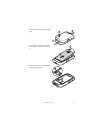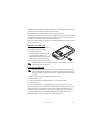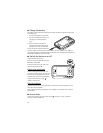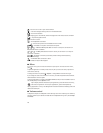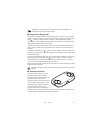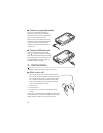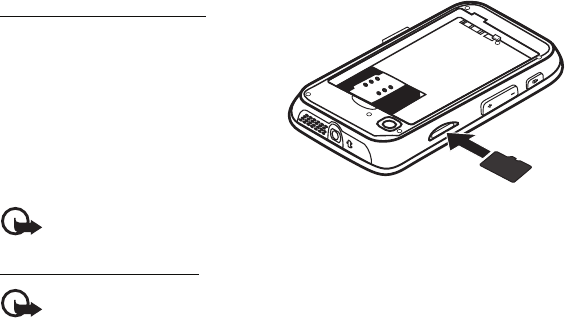
11
Get started
some brands may not be fully compatible with this device. Incompatible cards may damage
the card and the device and corrupt data stored on the card.
Keep microSDHC and microSD cards out of the reach of small children.
You can extend the available memory with a microSDHC or microSD card with a capacity of
up to 8 GB. Optimal performance is with a 4 GB microSD card. You can insert or remove a
microSDHC or microSD card without switching the device off.
To maximize the performance of your device, it is recommended that no more than 100 files
are stored in any folder.
Insert the microSD card
The memory card may be supplied with the
device, and may already be inserted.
1. Remove the back cover.
2. Insert the memory card in the slot with
the contact area as shown in the
graphic. Make sure that the contact area
is facing the connectors on the device.
3. Push the card in until it locks into place.
Important: The microSD card must be inserted in the slot with the gold-colored
area facing the front of the device.
Eject the microSD card
Important: Do not remove the memory card in the middle of an operation when
the card is being accessed. Removing the card in the middle of an operation may
damage the memory card as well as the device, and data stored on the card may be
corrupted.
1. Press the power key briefly, and select Remove memory card.
2. Remove the back cover.
3. Press the end of the memory card to release it from the memory card slot.
4. Replace the cover.
After you install applications to a compatible memory card, installation files (.sis, .sisx)
remain in the device memory. The files may use large amounts of memory and prevent you
from storing other files. To maintain sufficient memory, use Nokia PC Suite to back up
installation files to a compatible PC, then use the file manager to remove the installation
files from the device memory. See
"Install an application," p. 50. If the SIS file is a
message attachment, delete the message from the Messaging inbox.









